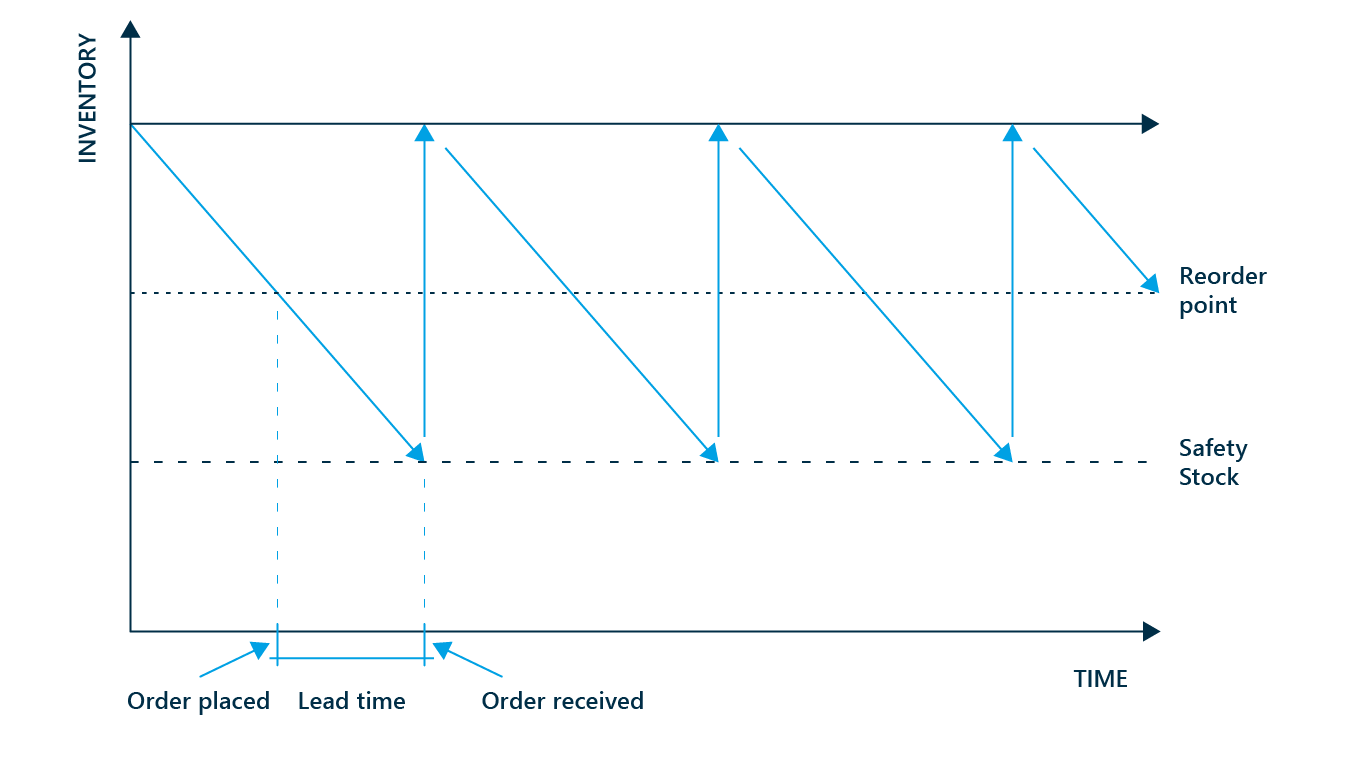Table of contents
Table of contents- How Can You Leverage The Reorder Point to Enhance Supply Chain Efficiency?
- What is the reorder point?
- Reorder point formula
- Variables to consider when establishing the reorder point
- Risks of a poorly defined reorder point
- How is the reorder point optimised?
- How does the reorder point relate to the EOQ?
- Collaboration with suppliers at the point of reorder
- Reorder point automation
- Alipensa optimises its ordering process with Slim4
- Conclusion: Keep your reorder point up-to-date!
- Reorder points FAQs
Risk management is one of the main tasks of supply chain managers. In the field of supply chain planning, this usually means choosing between two options: a high inventory level, which minimises the risk of lost sales and raises the level of service; or a tighter stock, which unlocks working capital and mitigates the risks of product obsolescence.
The classic blanket theory: you can cover your head or your feet, but not both…
Choosing one option or the other is a strategic decision. It will depend on the level of service you want to offer your customer and the resources the company is willing to allocate for this purpose. Depending on these variables and the anticipated demand, an optimal stock level can be calculated.
This initial amount of inventory, however, will be consumed as demand is met. For this reason, in order to get back to square one – ie the optimal stock level – a reorder point must be established that allows replenishment to be carried out at the right time.
What is the reorder point?
Let’s start by defining the concept. The reorder point is a term used in stock management and logistics to determine when to reorder a particular item. It’s calculated by considering the current inventory level, the demand for the item, and the time it takes for an order to be delivered.
Basically, the reorder point is set to ensure that a product does not become out of stock. When the inventory level reaches the reorder point, it’s the signal to call the supplier for replenishment before the inventory level drops to undesirable levels. This ensures that sufficient stock is available to meet demand, while waiting for a new order to arrive.
Establishing an appropriate reorder point helps to avoid shortages or overstocking, helping the company to maintain an optimal stock level.
Reorder point formula
The formula for setting the reorder point is as follows:
Reorder Point = (Delivery time in days * forecast demand calculated for those days) + safety stock
Variables to consider when establishing the reorder point
When defining the reorder point, the following variables are crucial:
- Demand forecast: The expected demand for the item in the following days/weeks/months.
- Delivery time: The period between the order request and the receipt of the replenishment.
- Safety stock: An additional quantity to cover variations in demand or delivery delays.
- Variability of demand and lead times: To adjust safety stock.
- Associated costs: These include storage, ordering and shortage costs.
- Data reliability: Accurate and up-to-date data on demand, delivery times and market trends.
Risks of a poorly defined reorder point
Defining the reorder point at a higher or lower level than the optimal poses a number of risks for companies. Let’s look at them.
Risks of a too high reorder point
The main risk here is that excess stock will accumulate and this will lead to a series of issues for the company.
Financial costs
Holding excess inventory means tying up capital in products that are not selling. This can have a negative impact on liquidity, and warehousing costs.
Obsolescence
Products stored for a long time can become obsolete , especially in industries where technology or trends change rapidly. This leads to losses from products that are no longer in demand or, in the case of food, can no longer be consumed because their ‘use by’ dates have expired.
Storage costs
Holding excess inventory requires additional storage space, which increases associated costs such as warehouse rental, insurance, security and labour.
Reduction of inventory turnover
Excess inventory can make it difficult to introduce new products or improved versions, as well as adapt to changes in market demand.
Risks of a too-low reorder point
Conversely, a reorder point that is too low – ie causing the replenishment process to take too long – also has drawbacks.
Decrease in sales
Lack of product availability can directly impact sales, because you will not be able to capitalise on existing demand.
Loss of customers
Beyond holding a one-off sale, customers may switch to your competitors if they do not find the product they want in your company’s offering.
Reputational damage
Lack of consistent availability can damage a company’s reputation, leading to a negative perception of its ability to meet customer needs.
Missed opportunities
If demand cannot be met, opportunities to generate revenue and reach new markets or customer segments are lost.
Higher operating costs
Lack of availability may force ‘emergency’ purchases, accelerated production or express shipments, which can increase operational costs.
Impact on planning
Product shortages can destabilise distribution and marketing plans, affecting the company’s long-term planning.
Other risks associated with the reorder point
Beyond overstocking or understocking, we can identify other risks that also need to be taken into account.
Production stoppage
In manufacturing companies, failure at the point of ordering an item from the bill of materials can mean that, even if the rest of the operation is running smoothly, the production process is forced to stop.
Deterioration of interdepartmental relations
An inappropriate reorder point not only affects customer service, but it can also strain interdepartmental relationships. Lack of product will undoubtedly displease the sales team, as it will the finance team if unnecessary overstocking occurs.
Finally, it should also be noted that in retail environments, a general feeling of stock shortages is sometimes blamed on a bad reorder point. However, it may be due to other causes, such as poor distribution of the product at the different points of sale.
How is the reorder point optimised?
To optimise the reorder point, consider these steps:
- Data accuracy: Use accurate demand data and lead times to calculate the order point more effectively.
- Periodic review: Regularly update formula parameters (demand, lead times) to reflect changes in purchasing patterns or suppliers.
- Optimised safety stock: Evaluate and adjust the level of safety stock to mitigate risks without increasing storage costs.
- Automated systems: Use inventory management software that dynamically calculates and adjusts the reorder point so that it is always up to date.
- Cost analysis: Evaluate the balance between storage costs and shortage costs to determine the optimal reorder point.
How does the reorder point relate to the EOQ?
The reorder point and Economic Order Quantity (EOQ) are interrelated in inventory management in the following ways:
- Reorder point: Determines when to place an order based on demand and delivery time.
- EOQ: Calculates the optimal reorder quantity to minimise total inventory costs, taking into account ordering costs and inventory holding costs.
Reorder point synchronisation with EOQ ensures efficient replenishment; the order is placed when the reorder point is reached and the optimal quantity is ordered according to EOQ, minimising storage and ordering costs. Both concepts complement each other for efficient and cost-effective inventory management.
Collaboration with suppliers at the point of reorder
Lead time is one of the most important elements when defining the reorder point. This variable depends mainly on the supplier, so collaboration with them is a vital part of the calculation process. Some of the benefits that can be achieved are:
- More accurate delivery times: Sharing information on demand and buying patterns allows suppliers to adjust delivery times, influencing accurate reorder point calculation
- Reduced lead times: Effective communication can streamline the shipping and receiving processes, minimising the time between order and replenishment.
- Innovation in logistics: Collaborating on logistics strategies can improve efficiency in the supply chain, reducing costs and time, and optimising inventory replenishment.
- Analyse different logistics flows: Especially in logistics structures with more than one stock point, optimising the “reference – delivery point” relationship will bring both economic and operational benefits.
- Improving business relationships: Close collaboration builds strong relationships, generating trust and enabling flexible agreements that benefit both parties in terms of quantities, timing and costs.
- Adapting to change: Collaboration facilitates rapid adjustments to changes in demand or the market, allowing the reorder point to be changed quickly and accurately.
Reorder point automation
Reorder point automation is achieved through advanced inventory management systems. Here are some key points to consider:
Specialised software: Inventory management software that offers automatic reorder point calculation functions will result in greater accuracy.
Data integration: Connecting the software with data sources that are always up to date ensures accurate information on demand and delivery times.
Calculation algorithms: The software implements algorithms that automatically consider demand, lead times and safety stock to calculate the reorder point dynamically.
Automatic alerts: You can set up automatic alerts that notify you when inventory reaches or falls below the reorder point, automatically triggering the replenishment process.
Supplier integration: The software enables the establishment of electronic connections with suppliers to streamline the transmission of orders and the confirmation of delivery times.
Alipensa optimises its ordering process with Slim4
Alipensa, a group specialising in consumer goods retail and Cash&Carry centres for food and hospitality professionals, has experienced accelerated growth in recent years, which has led to a 40% increase in turnover over the last decade.
After implementing Slim4, Alipensa was able to optimise the ordering process to hold only the stock it needed, while increasing the efficiency of the purchasing team through greater visibility and a higher degree of automation. “Our expansion process brought us to a point of no return, where we either automated part of the supply chain management or operations would collapse,” says Pedro Márquez Padillo, Alipensa’s logistics director.
Conclusion: Keep your reorder point up-to-date!
Calculating the reorder point one day and then not revisiting it for months is unproductive. The benefit of maintaining a reliable reorder point is that it is always in line with the actual behaviour of the products. The value lies not only in the quality of its calculation but also in the frequency with which it is updated.
It is also important to bear in mind that, in order to obtain the full benefit of a good reorder point, it must be calculated individually for each “reference – stock point” combination, be kept up to date and is always looking forward to the future. If we focus the calculation on the past, we would not be taking into account seasonalities or trends, which would make it much more likely to cause errors in its calculation.
Reorder points FAQs
What is the importance of the reorder point?
The reorder point in inventory management marks the optimal stock level which, when reached, indicates that a replenishment order must be placed. In this way, the reorder point determines when to procure more product in order to maintain operations and avoid stock-outs and overstocking.
What are the risks and benefits of an optimised reorder point?
An unoptimised reorder point – either because it is set too high or too low – can result in overstocks or stock-outs. This will cause higher financial costs, product obsolescence or increased storage costs. In the case of breakages, this will mean lost sales and damage to the brand image amongst other things. With an optimised reorder point, all these risks are mitigated.
How can the reorder point be optimised?
There are several actions that contribute to optimising the reorder point. Having an accurate demand forecast, periodically reviewing the reorder point to update the formula, or optimising the safety stock are some good practices to keep the reorder point in its optimal state.
How can the reorder point be automated?
Reorder point optimisation should be a dynamic and automated process. To achieve this, it is advisable to use sophisticated software that allows data integration and has appropriate calculation algorithms and automatic alerts that notify when the reorder point is reached.







